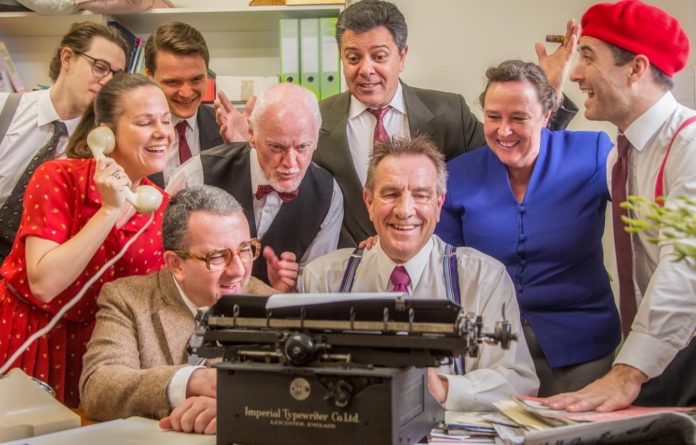Neil Simon based this play on his experience as a writer on the 1950s television comedy series Your Show Of Shows starring Sid Caesar. True to its origins, the script, especially in Act 1, is replete with one-liners and fast-paced dialogue between the seven comedy sketch writers as well as Max Prince, the show’s star, along with the office secretary, Helen. The play reflects its setting: the impact on such production companies of the economic and political pressures of the era, not the least of which was the threatening menace to the arts of then-rampant McCarthy-ism.
This production is David Grybowski’s directorial debut and he has begun with flair. The play was introduced by a comedy duet of cleaning ladies cracking one-liners with humour and timing. It was a suitable curtain raiser to the main event, and certainly got the audience laughing. Importantly, too, they established the Jewishness of the comedy we were about to see. The sea-gull/bay-gull/(bagel) gag was a case in point. They also enjoined us to cheer each character’s first entrance, prompted by a flashing Applause sign above the stage. While that worked well for most entrances, it obscured dialogue for others.
Precise timing is essential for the success of comedy, particularly its cheeky, wise-cracking New York Jewish form. Grybowski’s cast mastered it, with both dialogue and the physical gags. It was a fine example of an ensemble working together to secure the aims of the play. All performers established their characters early and used that to bounce comically off each other.
Robert Baulderstone provided unity, and some sanity, to the office in his role as Lucas, the Neil Simon character who was both participant and occasional narrator. He had an agreeable and open demeanour and in Act 2 did well to sustain the darker mood, especially when reflecting on the reasons for the comedy show’s decline and demise.
The rest of the writing team were individually unique and explored that individuality with expertise. They were funny in their own right but often because others made fun of them. Frank Cwertniak as Val the lead writer was deadpan, gruff and solid while, by dint of his exceptional timing, very funny. Chris Gun was a whirlwind of physical comedy as Milt and showed secure control in the rapid-fire delivery of his lines. His embarrassment about wearing the white suit was particularly well played, as was the hat swapping and eye poking routine with Brian, evoking the Three Stooges. Indeed, as the Irish writer Brian, Thomas Filsell provided another welcome perspective. He was accent-perfect and quietly amusing in his observations and in the way he related to the others on his return visit to the office from his time in Hollywood.
Andrew Horwood made the most of his role as the hypochondriac Ira. He frequently brought the character to the verge of mania, yet managed the balance between being essentially unlikeable to almost all of the other characters yet drawing on the audience’s empathy.
Anthony Vawser as Kenny and Jo Coventry as Carol were key to the continuing comedy, too, as was Lauren Weber as the would-be comic writer who was all too literal for that ever to happen.
Gavin Cianci played the indefatigable Max Prince, the star of the Max Prince Show. His characterisation was splendidly sustained. He had the required comic touch, coupled with the despair Max felt when dealing with the show’s producers who wanted changes in its emphasis and cuts to the budget and staff. He was very funny in the sustained gag about his misunderstanding about the late night phone calls he’d made but forgotten. It’s a peculiarly American form of humour and style of presentation. Cianci mastered both.
The set was perfectly functional, with photo and poster covered office walls and a large window upstage, behind which played appropriate still and moving visual images from the era. The one with perhaps the most apparent audience impact came at the beginning of interval. It was a 1950s television ad in which doctors were promoting the benefits of cigarettes. That was a clever reminder of the historical social context of the play itself.
Whether you are suited by the type of humour of this comedy or not, the Rep’s cast and production team gave us a skilled, high-paced and faithful rendition of it in Laughter on the 23rd Floor. Significantly, the audience laughed loudly and often.



